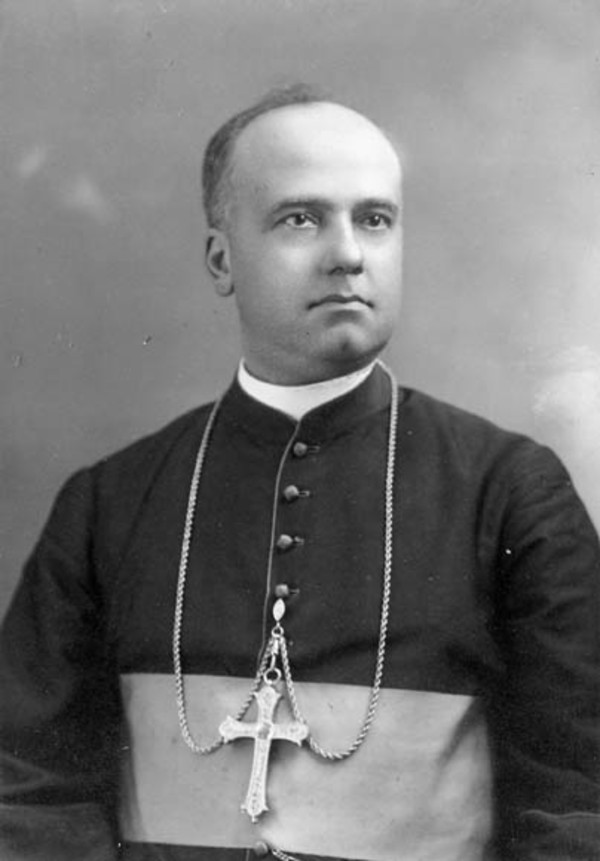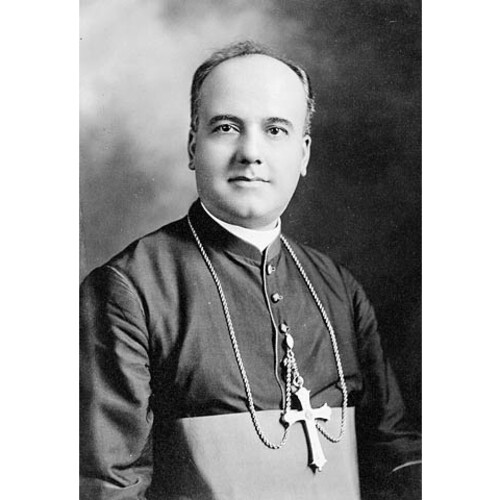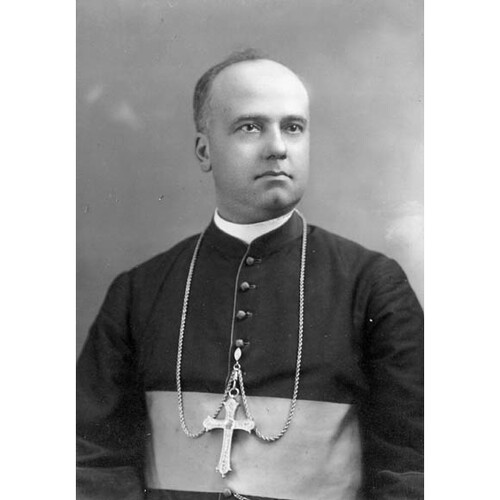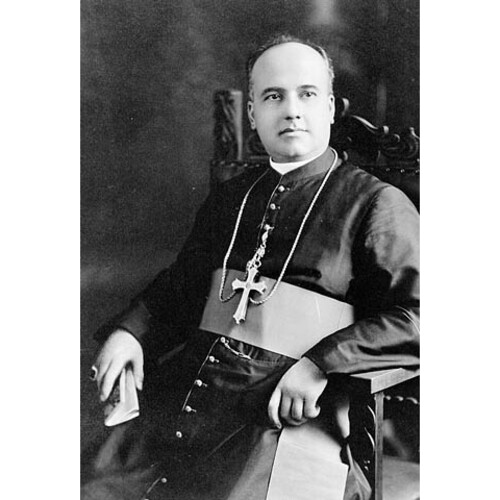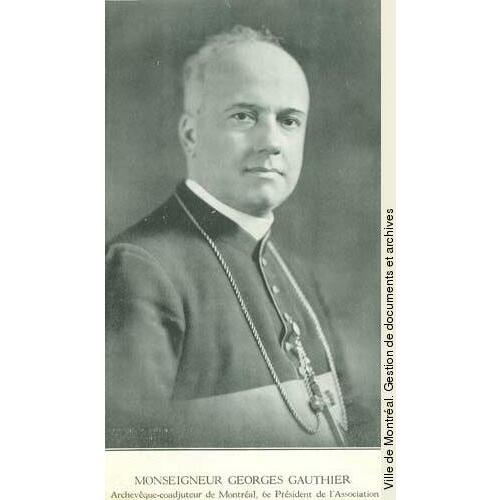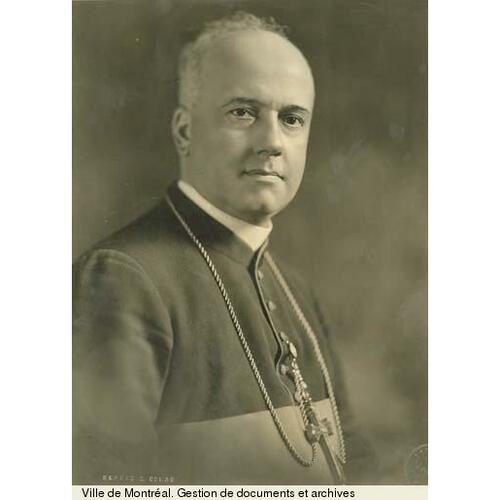Gauthier, Georges (baptized Louis-Antoine-Alexandre), Roman Catholic priest, teacher, school administrator, and archbishop; b. 9 Oct. 1871 in Montreal, son of François-Xavier Gauthier, a telegraph operator, and Marie-Louise Généreux; d. there 31 Aug. 1940.
At the age of nine months the infant who had been baptized Louis-Antoine-Alexandre lost an elder brother called Joseph-Adolphe-George. It was probably at this time that he inherited the first name by which he would henceforth be known: Georges. After pursuing classical studies at the Petit Séminaire de Montréal (1884–89) and theology at the Grand Séminaire de Montréal, Georges Gauthier was ordained priest on 29 Sept. 1894 by the archbishop of Montreal, Édouard-Charles Fabre*. That year he left Montreal for Rome, where he took courses at the Apollinaris College (1894–95) and at the Roman College (1895–97), from which he received a doctorate in canon law.
On his return to Montreal in 1897, Gauthier taught canon law at the Grand Séminaire for a year. After serving as the chaplain at the Pensionnat Mont-Sainte-Marie from 1899 to 1901, he was appointed chaplain and curate at the cathedral, and, in February 1904, titular canon of the metropolitan chapter. He subsequently became curé of the cathedral parish, a post he would hold until 1918.
Owing to the illness of the auxiliary bishop, Zotique Racicot*, on 24 Aug. 1912 Gauthier was consecrated auxiliary to Paul Bruchési, archbishop of Montreal, with the title of bishop of Philippopolis in Arabia. He became vicar general in April 1919. He was promoted to apostolic administrator on 18 Oct. 1921 and then to archbishop of Tharona and coadjutor with right of succession on 15 April 1923. Gauthier was now able to pursue the projects initiated by Bruchési, who since the beginning of the 1920s had been suffering from an illness that made him unable to make decisions. As coadjutor, Gauthier administered the archdiocese for 18 years, until Bruchési’s death on 20 Sept. 1939. On that day he became archbishop of Montreal; he was honoured with the pallium on 11 December. To mark his silver jubilee as bishop, on 30 Sept. 1937 he had been appointed assistant to the pontifical throne and Roman count.
Gauthier worked energetically in various other areas, starting with teaching. On 12 Sept. 1917 he was appointed vice rector of the Université Laval in Montreal; on 19 June 1920, following the grant of a civil charter that conferred independence on the Université de Montréal, he became its first rector. During his term he created the faculties of letters (1920), sciences (1920), and philosophy (1921), and he set up the École des Sciences Sociales, Économiques et Politiques (1920) [see Édouard Montpetit*]. The École de Chirurgie Dentaire de l’Université de Montréal acquired the status of faculty in 1920, and that same year the École de Médecine Comparée et de Science Vétérinaire de Montréal became the first affiliated institution [see François-Théodule Daubigny].
Gauthier also devoted his efforts to improving teacher and pre-university training. In his circular of 4 Nov. 1925 he announced the creation of a new educational institution for which the Congregation of Notre-Dame would be responsible. The Institut Pédagogique, which opened in 1926 through the efforts of Mother Sainte-Anne-Marie [Marie-Aveline Bengle] and which the following year was affiliated to the Université de Montréal, provided advanced training to nuns and lay teachers. Gauthier founded day schools that offered classical studies to boys (for example, the Collège Grasset in 1927 and the Collège Sainte-Croix in 1929), as well as the Institut Pédagogique Saint-Georges (1929), to give university-level training in school administration and professional orientation to elementary-school teachers. To preclude the founding of lay French secondary schools, he backed the creation of the Collège Stanislas for boys (a branch of the institution of the same name in Paris) in 1937, and later, in 1939, the opening of the Collège Marie de France for girls. That year he granted anglophone Roman Catholics a section of the École Normale Jacques-Cartier. Finally, he set up several scholasticate normal schools, which offered teacher training to members of religious orders and nuns.
At the end of his rectorate in 1923, Gauthier became chancellor of the university. In this position, which he would retain until his death, he continued his efforts to ensure the institution’s autonomy; its independent status was permanently established by a decree from Rome in 1924 and a papal bull in 1927. He also worked on plans and financing for the new campus, which would be built on the north slope of Mount Royal between 1928 and 1943 [see Ernest Cormier*]. In 1937 he founded the Institut Pie XI, a school for Catholic action and the study of religious sciences; it was annexed the following year to the university’s faculty of theology. On 28 April 1939 the Union Nationale government of Maurice Le Noblet Duplessis* enacted a law to assist the Université de Montréal, which established the Société d’Administration de l’Université de Montréal for a period of ten years. The principal aim of this body, of which Gauthier was overseer and president, was to approve the budget of the university, which was mired in financial problems.
Out of concern for public morals, Gauthier forbade raffles, games of chance, and dances. He lashed out at immoral theatrical performances, which he did not allow priests to attend. He was particularly troubled by plays imported from France. The mediocrity, and sometimes vulgarity, of films produced in the United States prompted him to denounce them as well as the tabloid press. Although Gauthier was in favour of women’s education, he took a public stand against their right to vote [see Marie Lacoste*]. Le Devoir reported his remarks on 5 April 1928: “Feminism is a sickness which must be cured by workings other than those of politics: when you have one more female member of the legislature, you will solve nothing.” Such a mistrustful, regressive, and even closed-minded attitude was characteristic of those who carried out charitable social work in the archdiocese. Gauthier asked Catholics to avoid all outside influences to protect themselves from the neutralism and scourge of indifferentism. He perceived cooperation between Catholics and Protestants as a threat.
For Gauthier, however, the enemy that needed to be defeated was without question communism, whose anti-religious campaign was an “engine of war” against the very idea of religion, as he stated in his circular of 11 Jan. 1931 on Bolshevik propaganda. In his pastoral letter of 11 Feb. 1934 on communism and socialism (“the precursor of communism”), he presented “three errors [that] characterized the socialism condemned by the Church: the suppression or excessive diminution of private property, the class struggle and a materialist concept of the social order.” At the same time, he rejected the program of the Co-operative Commonwealth Federation, “[a] form of socialism that is not worthy of Catholic membership.” In a circular published on 1 Oct. 1936, he denounced the Spanish Civil War, which he saw as “religious persecution” led by the communists. He wondered whether “the minds of our Catholics [are] sufficiently alert to the communist threat.” His circular of 15 March 1938 indicated that he feared the emerging campaign against fascism, for it risked creating the impression that communism was not the real danger. Gauthier stressed that he was not in any way a “defender” of the Parti National Social Chrétien [see Adrien Arcand*]: “It is [the same as] German Nazism, with its errors and its tendencies, and of which we have taken care to round the sharpest edges in order to make it acceptable to our own Catholics.”
Among Gauthier’s priorities were Catholic trade unionism, social action, and Catholic action: for him they formed a bulwark against communism. To ensure that Montreal workers were informed about trade unionism, the coadjutor archbishop had, in 1924, obtained the support of the Belgian Dominican Georges-Ceslas Rutten, a union leader, founder of the Secrétariat Général des Unions Professionnelles Chrétiennes, and a disciple of Frédéric Le Play, a French economist and sociologist. Two years later he sent Abbé Aimé Boileau, chaplain to the Catholic unions, to study social issues in Europe. In 1927 he approved a proviso concerning reasonable salaries and preferred treatment for unions. The stipulation, which had to appear in all quotations for the construction of religious buildings, asked entrepreneurs to compensate their workers according to a predetermined pay scale and to favour the hiring of members of the Catholic unions. In 1932 Gauthier also published a circular, intended for workers, owners, and companies, about establishing fair remuneration.
At Gauthier’s request, Henri Roy, an Oblate father of Mary Immaculate, went to Belgium in 1931 to learn more about the Jeunesse Ouvrière Chrétienne, a movement founded there by Abbé Léon-Joseph Cardijn in 1925, with the aim of introducing the organization into his archdiocese. In 1931, at Gauthier’s suggestion, the Jesuit Joseph-Papin Archambault* created and headed the Comité des Œuvres Catholiques de Montréal, which brought together for consultation the union leaders of all the large Catholic associations in Montreal. In his circular of 19 March 1936, Gauthier described the structure of the Association Catholique de la Jeunesse Canadienne-Française, which then became the general framework for all specialized movements for Catholic action so as to establish a common direction and fight communism.
For almost 30 years Gauthier was thus directly tied to the service of the archdiocese. Under his administration the Catholic population of Montreal grew from 633,538 in 1921 to 815,481 in 1940. The coadjutor archbishop established 37 new parishes. The papal bull of Pope Pius XI founded the diocese of Saint-Jean-de-Québec on 9 June 1933. It was detached from the archdiocese of Montreal, and it encompassed 41 parishes and some 65,000 Catholics. Anastase Forget* became its first bishop. Gauthier favoured the welcoming of Catholic immigrants of diverse origins; he created parishes for them and agreed to let their priests minister in their own language. In 1926 he invited the Sœurs de Saint-François d’Assise to run the Hôpital Français, which was set up in 1919 by lay people [see François de Martigny]. In 1933 he asked the Little Sisters of the Assumption to look after poor working-class families in their homes and to uncover cases of destitution in Montreal’s Catholic schools. He canonically erected three religious communities: the Institut des Sœurs de Notre-Dame du Bon-Conseil (1923) [see Marie Gérin-Lajoie*], the Société des Filles Consolatrices du Divin Cœur (1933), and the Franciscan Oblates of Saint-Joseph (1935).
To ensure the development of the archdiocese of Montreal, Gauthier also supported public worship in the sanctuary of St Joseph, which was established on the slope of Mount Royal in 1904, at the instigation of Brother André [Alfred Bessette]. Upon Bessette’s death in January 1937, Gauthier would preside over the organization of his solemn funeral mass in the cathedral of Montreal, during which he sang the absolution. On 6 Jan. 1925 Gauthier canonically erected the Société des Missions Étrangères de la Province de Québec and its seminary [see Joseph-Avila Roch]. In response to the collapse of the parish of Saint-Étienne, whose curé had amassed debts of more than $600,000, in particular for building a church, he asked for changes to the Parish and Fabrique Act; these amendments, which received royal assent in 1932, restricted the ways in which parish corporations could borrow money.
A studious, reflective, and highly cultivated man, Gauthier had built a 5,000-volume library, which he bequeathed to the Institut Pédagogique. The collection included the most recent books on spirituality, as well as numerous volumes on Catholic action and the social sciences, not to mention classic works in the fields of science, art, and literature. The publications of Charles-Émile Freppel, Charles Forbes, Comte de Montalembert, Frédéric Ozanam, and Albert de Mun ranked high among them, along with those of Louis Veuillot and Joseph de Maistre. In Canada Gauthier was considered a clergyman of exceptional authority. Elsewhere he enjoyed the esteem of Pope Pius XI and of cardinals Jean Verdier, archbishop of Paris, and George William Mundelein, archbishop of Chicago. Having the gift of a vibrant voice, he was a powerful, effective, convincing, and valued speaker who delivered addresses to international eucharistic conferences in Montreal (1910); Lourdes, France (1914); Chicago (1926); and Quebec City (1938). According to the account of Abbé Élie-Joseph-Arthur Auclair, published in 1941 in Canada ecclésiastique, “he had everything it took to be an outstanding orator. Elevated and sustained thought, vivid development [of ideas] that were full of imagery, perfect and such captivating diction, natural and magnificent gestures, a warm and friendly voice – he lacked nothing.”
Georges Gauthier died on 31 Aug. 1940, a few days after suffering a coronary thrombosis. As a sign of esteem for his first teachers, he had requested a plain wooden coffin covered with a black pall and a funeral service with no eulogy. These symbols of humility, faithful to the Sulpician tradition, exemplify the life of the man who was charged with serving as an archbishop for almost 20 years yet bore the title for only a few months. His accomplishments are no less numerous and varied, however; they include the building of the mortuary chapel of the bishops and archbishops of the cathedral of Montreal, which he had initiated in 1930 and inaugurated three years later, and where he now rests.
BANQ-CAM, CE601-S51, 9 juin 1869, 9 oct. 1871, 10 juill. 1872. FD, Saint-Jacques, cathédrale de Montréal [Saint-Jacques-le-Majeur], 13 sept. 1940. Le Devoir, 5 avril 1928; 3, 5 sept. 1940. La Semaine religieuse de Montréal, 4 sept., 20 nov. 1940. H.‑A. Bizier, L’Université de Montréal: la quête du savoir (Montréal, 1993). Canada ecclésiastique, 1898–1941. Raoul Drouin, Monseigneur Georges Gauthier, archevêque de Montréal (Montréal, 1946). Histoire du catholicisme québécois, sous la dir. de Nive Voisine (2 tomes en 4v. parus, Montréal, 1984– ), tome 3, v.1 (Jean Hamelin et Nicole Gagnon, Le XXe siècle (1898–1940), 1984). LeBlanc, DBECC. Mandements, lettres pastorales, circulaires et autres documents publiés dans le diocèse de Montréal depuis son érection (30v., Montréal, 1887–1962), 17–18. Monique Montbriand, “Monseigneur Georges Gauthier, cinquième évêque de Montréal (1939–1940),” dans L’Église de Montréal: aperçus d’hier et d’aujourd’hui, 1836–1986 ([Montréal, 1986]), 100–4. Hélène Pelletier-Baillargeon, Marie Gérin-Lajoie: de mère en fille, la cause des femmes (Montréal, 1985). Antonio Perrault, “Monseigneur Georges Gauthier,” L’Action nationale (Montréal), 16 (1940): 96–101. Denise Robillard, Monseigneur Joseph Charbonneau: bouc émissaire d’une lutte de pouvoir ([Québec], 2013); L’Ordre de Jacques Cartier, 1926–1965: une société secrète pour les Canadiens français catholiques ([Montréal], 2009). La Vie syndicale (Montréal), mai 1927.
Cite This Article
in collaboration with Denise Robillard, “GAUTHIER, GEORGES (baptized Louis-Antoine-Alexandre),” in Dictionary of Canadian Biography, vol. 16, University of Toronto/Université Laval, 2003–, accessed January 1, 2026, https://www.biographi.ca/en/bio/gauthier_georges_16E.html.
The citation above shows the format for footnotes and endnotes according to the Chicago manual of style (16th edition). Information to be used in other citation formats:
| Permalink: | https://www.biographi.ca/en/bio/gauthier_georges_16E.html |
| Author of Article: | in collaboration with Denise Robillard |
| Title of Article: | GAUTHIER, GEORGES (baptized Louis-Antoine-Alexandre) |
| Publication Name: | Dictionary of Canadian Biography, vol. 16 |
| Publisher: | University of Toronto/Université Laval |
| Year of publication: | 2020 |
| Year of revision: | 2020 |
| Access Date: | January 1, 2026 |


